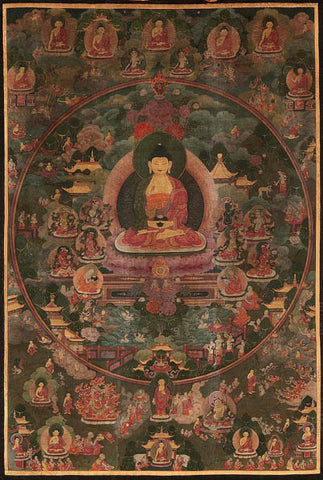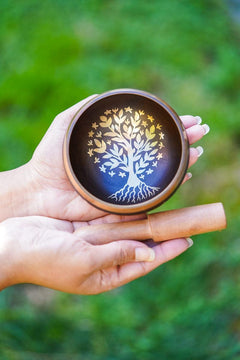All about Thangka
Introduction
Thangka paintings are Buddhist canvas paintings made of gold and other natural colors, depicting Buddhist deities, scenes or mandalas. They are usually small in size, each size ranging from 20 to 50 cm, usually square or rectangular. However, there may be paintings several feet long designed to be displayed on the walls of a monastery or as part of a religious festival. Thangka is commonly used for a number of different functions, images of gods can be used as teaching aids to describe the life (or lives) of Buddha, to represent historical events related to important lamas, or to tell myths involving other deities. Thangka are used as a centerpiece in meditation rituals and worshiper's' rituals.
History

Historically, the Thangka was used as a teaching aid. A lama carried portable painted scrolls depicting Buddhist teachings, important events, and various aspects of deities on his travels. Most thangkas were made by individuals usually monks, who acquire merits to do so. These arts were, then given to monastery or other individuals in exchange for “gifts” rather than a fee. The earliest survivals of Tibetan paintings on cloth are in some pieces from the Mogao Caves at Dunhuang on the Silk Road, in Gansu province, China. The "Library Cave" there was a repository of old or worn-out manuscripts, paintings, prints, textiles, and other items which was sealed off in the 11th century,As few as 20 surviving forms of this art from the 11th and 12th century remains. Over the centuries thangka paintings, both on walls and cloths continued to develop in their distinctive style influenced by Indo-Nepalese and Han Chinese paintings, especially from the 14th century up to its peak in the 18th century.
The earliest surviving thangka paintings in Nepal date from the 14th century AD, however this was likely a considerable time after Buddhists and Hindus began to depict Gods and natural scenes on canvas. Paubhas (Tangkas) have long reflected Tibetan and Chinese influences in Nepali paintings, while Nepal's style has had a considerable influence on Tibetan art. During the reign of Angshuvarma in the 7th century AD, Mahayana Buddhism was introduced to Tibet through Nepal. As a result, religious symbols and Buddhist literature were in high demand for the newly constructed monasteries across Tibet. In the Kathmandu Valley, several Buddhist manuscripts, including the Prajnaparamita, were copied for these monasteries.
Religious paintings revered as an icons are called Paubha in Newari and Thangka in Tibetan.Paubha or thangka paintings can be traced all the way back to Nepalese artisans who created some of Tibet's most remarkable wall and metallurgical paintings, as well as illuminated manuscripts. Recognizing the high demand for religious symbols in Tibet, these artists, along with monks and merchants, brought metal sculptures as well as Buddhist manuscripts from Nepal. Amitabha Buddha is surrounded by bodhisattvas in one of the earliest examples of Nepalese Thangka art, which dates from the 13th/14th century. One of the earliest known inscription thangkas is a Nepalese thangka with three dates inscribed in the inscription (the most recent being 1369 AD). Early Nepalese Tangkas are simple in design and composition. The main deity, a large figure, occupies the central position while surrounded by smaller figures of lesser divinities.
Types
Based on technique and material, tangkas can be grouped by types. Generally, they are divided into two broad categories: those that are painted (palas) and those made of silk, either by appliqué or embroidery.
- Palas –The illustrative paintings of the deities is known as Palas. This is the most common type. The Palas can be further divided in four categories:
- Peaceful Deities- They are Buddha, Bodhisattva, Guru and High Monk with Calm, soothing features that help us nurture the qualities of the Buddha.

- Wrathful Deities- They are the protector deities, used to protect Buddhism and destroy the three major obstacles to enlightenment. (anger, greed and ignorance)

- Yidams- The Yidam is a special deity. One which works with in meditation as a means towards recognizing one's own awakened nature.

- Mandalas- Mystic diagrams paintings of complex text, circles and square each having specific significance.

- There exists another style of Thangka that depicts scriptures and historical events that is of great importance i.e. Wheel of life, Buddha Life, Four Harmonious friends and many others.

Process

The Thangka Making process starts with preparing Canvas. The canvas is washed and scrubbed multiple times to confirm the essential even tension then the cloth is tied to an iron or wooden frame using cotton threads. The outline of the deity is first drawn on the prepared canvas with pencil. The drawing of Mandalas and Deity figure must be in accordance with strict guidelines as per the Buddhist scripture. The artist must be properly trained and have sufficient religious understanding, knowledge, and background to create precise and correct Thangka. The next step after the drawing is adding color to it. Traditionally, the paint consists of pigments in a water-soluble medium of animal glue. Both mineral and organic pigments are used, but nowadays acrylic paints have replaced it largely. The painting is done with fine brushes. The artist blends different hues and adds details to give depth to the image, In Nepal, 24 carat gold is also plated over some parts of Thangkas painting which makes the art a little more expensive. A fine Thangka can take a few months to complete. Thangka often overflow with symbolism and allusion. Because the art is explicitly religious, all symbols and allusions must be in accordance with strict guidelines laid out in Buddhist scripture. The artist must be properly trained and have sufficient religious understanding, knowledge, and background to create an accurate and appropriate thangka.
Mediating Guidelines
Historically used as teaching aid, Thangkas are used as a meditation tool to help bring one further down the path to enlightenment. Devotional images act as the centerpiece during a ritual or ceremony and are often used as mediums through which one can offer prayers or make requests.
Meditating on your mandala Thangka art:
Step 1: Sit restfully in front of your mandala.
Step 2: Breathe deeply and slowly, gazing upon mandala so that the image gradually goes out of focus.
Step 3: For about 5 minutes, meditate on the epicenter of your mandala shape, allowing its geometry to bring your mind to a state of balance. This is the space where the ego-self becomes less active.
Step 4: Meditating 15 minutes a day is encourage. When you feel ready, shift your attention elsewhere and enjoy the deep inner equilibrium that remainsWhere and how to hang Thangka art.
Where and how to hang Thangka art.

Hanging Thangka Art painting of Buddha, deities and Mandala will attract peace, joy, prosperity and luck. Thangka paintings are not just a piece of Art, it is considered to increase the positive energy in your space.
In Hindu and Buddhism Thangka is consider to be divine and spiritually charging. Here are some guidelines for how and where to hang the Thangka Art
- Hang your Thangka Painting high up on the wall. Hanging Thangka Touching the ground is not recommended.
- Don’t place it in a dark corner or in a place that is rarely visited by people in your family or workplace.
- Hang the Thangka Painting in your living area. Hang a Buddha painting right at the entrance and you will prevent negative energy from entering your home.
- If you want to attain a peaceful atmosphere while studying or working, you can use Buddha paintings in your study room to enhance concentration.
- Hang it on your meditation and Altar Space, Living room & knowledge room for positive energy.






Leave a comment